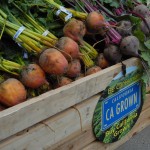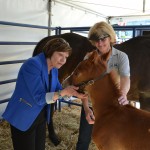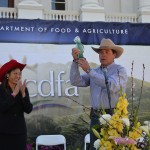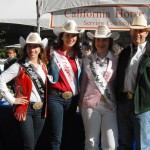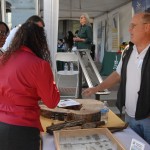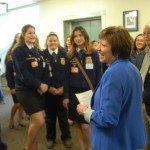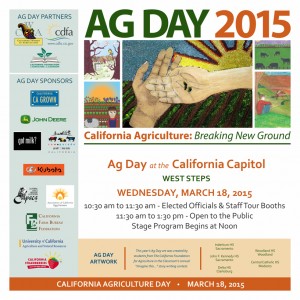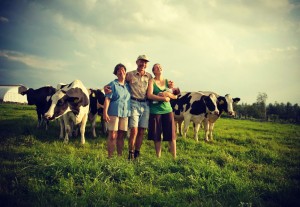U.S. Department of Agriculture (USDA) Secretary Tom Vilsack announced $57.9 million in funding, provided by the Agricultural Act of 2014 (the 2014 Farm Bill), to support project suggestions from across the country to prevent the introduction or spread of plant pests, diseases and pathogens, as well as to ensure the availability of a healthy supply of clean plant stock in the United States.
The economic stakes for stopping invasive species are high, with scientists estimating the total economic cost of all invasive species to be approximately $120 billion annually.
“Through the Farm Bill we are working with our partners and stakeholders to not only ensure the global competitiveness of our specialty crop producers but to fight back against the destruction caused by invasive pests,” said Vilsack. “The projects and centers funded through this effort are helping to develop and put in place the strategies, methods and treatments that safeguard our crops, plants, and our natural resources from invasive threats.”
Section 10007 of the 2014 Farm Bill supports two programs: Plant Pest and Disease Management and Disaster Prevention Programs and the National Clean Plant Network (NCPN). The Farm Bill provided $62.5 million for these programs in fiscal year 2015, though funding was reduced by sequestration.
Plant Pest and Disease Management and Disaster Prevention Programs
USDA’s Animal and Plant Health Inspection Service (APHIS) sought suggestions from states and U.S. territories, universities, federal agencies, nongovernmental organizations, private companies and tribal organizations for projects that would provide a direct impact in managing pests and diseases, as well as disaster prevention. APHIS is funding 438 suggestions across the United States, as well as in Guam and Puerto Rico. The projects approved for allocation will help states and other partners continue providing and strengthening protections against agricultural threats and could also allow the reallocation of resources to other critical programs.
View the full list of funded Plant Pest and Disease Management and Disaster Prevention Programs suggestions in the FY 2015 funding plan here.
Funded Plant Pest and Disease Management and Disaster Prevention Programs suggestions include:
- $170,000 for a statewide survey for Khapra Beetle in California;
- A total of $165,975 to study attractants for the Giant African Land Snail shared by California, Hawaii and Florida;
- $290,951 to analyze adult honey bee samples from across multiple U.S. states for diseases and pests such as the Varroa mite, to continue monitoring honey bee health across the United States;
- $504,317 for 39 states to survey bee populations and study bee health;
- $787,679 for eight Tribal projects to support outreach and education initiatives and projects related to mitigation and control strategies of invasive pests; and
- Funding for states to enhance their ability to survey for grape commodity pests and disease ($489,405), stone fruit pests ($1.07 million) and small fruit and mixed berries ($155,443)
Prospective projects were evaluated by teams comprised of USDA experts and industry representatives and were selected based on criteria that supported six goals — enhancing plant pest/disease analysis and survey; targeting domestic inspection activities at vulnerable points in the safeguarding continuum; enhancing and strengthening pest identification and technology; safeguarding nursery production; enhancing mitigation capabilities; and conducting outreach and education about these issues. The teams also evaluated submissions based on expected impacts of the project, the technical approach, and how submissions would complement ongoing USDA programs and other previously funded projects.
National Clean Plant Network
APHIS is allocating $5 million in funding as part of the National Clean Plant Network (NCPN) in support of 25 projects in 18 states that focus on providing high quality propagated plant material free of targeted plant pathogens and pests. The Farm Bill funds provided to the NCPN help maintain the infrastructure necessary for growing disease and pest-free plants, improving diagnostic capabilities and providing therapeutic treatments in specialty crop plants, and establishing foundation stock. The goal is to make sure that disease-free, certified planting materials are available and ensure the global competitiveness of U.S. specialty crop producers. This year, APHIS is funding projects to support developing and propagating pest-free fruit trees, grapes, hops, berries, citrus, roses and sweet potatoes.
The NCPN Governing Board, which is comprised of USDA representatives and members of the National Plant Board, recommended the projects to be funded. Priority was given to projects that support existing facilities with established capabilities for maintaining and providing nuclear/foundation stock, and for conducting diagnostics and different therapeutic treatments. The NCPN supported clean plant centers are recognized leaders for enabling the introduction of high quality, regionally adapted, propagative plant materials that are free of targeted plant pathogens and pests. This supports opportunities for international trade, while protecting American nurseries and growers.
View the full list of selected suggestions and the FY 2015 National Clean Plant Network funding plan here.
The public can help protect America’s agricultural and natural resources by being aware of invasive pests and the damage they cause. APHIS created the Hungry Pests public outreach program to empower Americans with the knowledge they need to leave these “hungry pests” behind. Visit http://www.Hungrypests.com during April, which APHIS has proclaimed Invasive Plant Pest and Disease Awareness Month, to learn more about invasive plant pest and diseases impacting your area and how you can help. And, join the discussion about invasive plant pests via the Hungry Pests Facebook page.
Today’s announcement was authorized by the 2014 Farm Bill. The Farm Bill builds on historic economic gains in rural America over the past six years, while achieving meaningful reform and billions of dollars in savings for taxpayers. Since enactment, USDA has made significant progress to implement each provision of this critical legislation, including providing disaster relief to farmers and ranchers; strengthening risk management tools; expanding access to rural credit; funding critical research; establishing innovative public-private conservation partnerships; developing new markets for rural-made products; and investing in infrastructure, housing and community facilities to help improve quality of life in rural America. For more information, visit http://www.aphis.usda.gov/farmbill.
Link to news release




